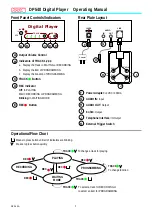
Special
Considerations
Here are some things to keep in mind when using
CALibration:TARE
.
Maximum Tare
Capability
The tare value that can be compensated for is dependent on the instrument
range and SCP channel gain settings. The following table lists these limits:
Table 4-6. Maximum CALibration:TARE Offsets
A/D range
±±
V F.Scale
Offset V
Gain x1
Offset V
Gain x8
Offset V
Gain x16
Offset V
Gain x64
16
3.2213
.40104
.20009
.04970
4
.82101
.10101
.05007
.01220
1
.23061
.02721
.01317
.00297
.25
.07581
.00786
.00349
.00055
.0625
.03792
.00312
.00112
n/a
Changing Gains or
Filters
If you decide to change a channel’s SCP setup after a
CALibration:TARE
operation you must perform a
*CAL?
operation to generate new DAC
constants and reset the “ range floor” for the stored Tare value. You must
also consider the tare capability of the range/gain setup you are changing to.
For instance, if the actual offset present is 0.6 Volts and was “ Tared” for a
4 Volt range/Gain x1 setup, moving to a 1 Volt range/Gain x1 setup will
return overload values for that channel since the 1 Volt range is below the
range floor as set by
CALibration:TARE
. See the table under
FORMat[:DATA]
in Chapter 5 for more on values returned for overload
readings.
Unexpected Channel
Offsets or Overloads
This can occur when your HP E1313/E1413’s Flash Memory contains
CALibration:TARE
offset constants that are no longer appropriate for its
current application. Execute
CALibration:TARE:RESet
then
*CAL?
to reset
the tare constants in RAM. Measure the affected channels again. If the
problems go away, you can now reset the tare constants in Flash memory by
executing
CALibration:STORe TARE
.
140 Understanding the HP E1313/E1413
Chapter 4
Artisan Technology Group - Quality Instrumentation ... Guaranteed | (888) 88-SOURCE | www.artisantg.com
















































